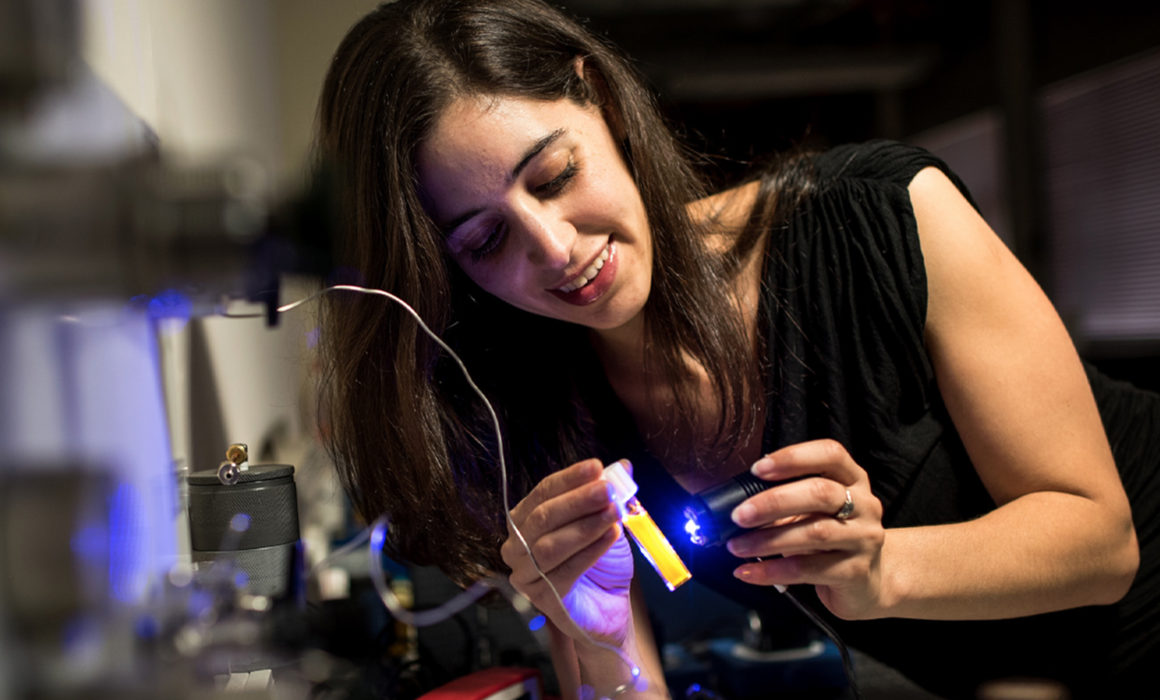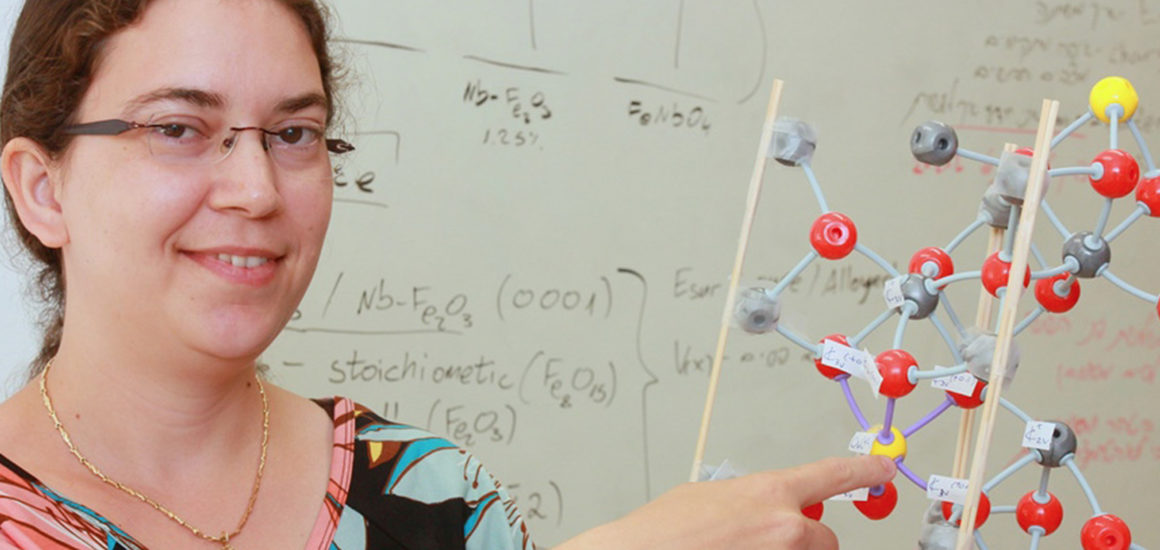Scientists struggling to perfect an efficient new way to produce hydrogen might feel an understandable touch of envy as they look out the window and see all those low-tech trees and plants doing the trick with such ease.
Hydrogen, the world’s most abundant element, has the highest energy per mass of any fuel. As such, it holds exciting potential as an emissions-free energy carrier. Small hydrogen fuel cells can power laptop computers and cellphones, while large ones can provide electricity to power buildings. Hydrogen-powered electric cars, in their infancy, are far more efficient than traditional vehicles. Today’s challenge is to produce hydrogen fuel cheaply and in large quantities.
Most hydrogen fuel is still produced from methane or natural gas, a process that requires large amounts of energy and releases greenhouse gases. Instead, scientists are developing ways to use the sun to produce hydrogen. Mimicking nature’s photosynthesis, researchers are tinkering with “water splitting,” the chemical process that separates hydrogen and oxygen into distinct gases.
“This is not only about technological advancement, but about discovering the secrets of the universe, since hydrogen production is also done in nature,” says Assistant Professor Maytal Caspary Toroker of the Faculty of Materials Science and Engineering. “Once we understand how nature works, we will be able to produce energy.” Associate Professor Lilac Amirav of the Schulich Faculty of Chemistry notes, “The energy that comes from the sun in one hour could supply global demand for a year.” But solar-powered splitting is not yet potent enough to power our cars, homes, and factories.
Energy research at the Technion is done under the umbrella of the Nancy and Stephen Grand Technion Energy Program (GTEP). “GTEP, as an interdisciplinary and interdepartmental program, strives to promote research that tackles energy-related challenges from different angles and reduces ‘barriers’ between departments and research areas,” says Professor Yoed Tsur, GTEP’s director.
Profs. Amirav and Toroker both lead GTEP teams seeking solutions. And they’re closing in on the answers from sharply different directions.
Associate Professor Lilac Amirav, Schulich Faculty of Chemistry at the Technion.
Separating the H2 from the O
To split a water molecule (H2O), run a current through it. You’ll watch protons and electrons play musical chairs as oxygen and hydrogen sort themselves out for separate storage, thanks to this simple electrolysis. To do it cleanly and greenly, scientists are investigating methods of photocatalytic water splitting, in which a semiconductor absorbs solar power to drive the reaction, aided by some kind of catalyst to accelerate the process.
As in photosynthesis, the solar energy is then converted into chemical energy. The newly created chemical bonds now hold the energy in fuel form, far easier to store than heat or electricity. The basic concept, Prof. Amirav explains, has been around for 40 years. But a truly practical system for large-scale use will need a much more efficient and stable semiconductor that is powerful, corrosion-free, and affordable.
Assistant Professor Maytal Caspary Toroker of the Faculty of Materials Science and Engineering.
Nickel for Your Thoughts
Scientists have been testing an arcane assortment of semiconductors and catalysts. Prof. Toroker’s team, for example, is gaining notice with their research on nickel oxyhydroxide, combined or “doped” with iron.
An accidental contamination hinted that this combo, in common use as a commercial battery, might be a winner. “I heard about this material at some international conferences and my curiosity was intrigued,” Prof. Toroker recalls. “Why does it work so well? It is still not well understood, but we do know iron can lose and receive electrons very easily. Our calculations show that especially in a nickel environment the electrons come loose and can activate the water.”
Those painstaking calculations involve “studying a material atom by atom,” says Prof. Toroker, a faculty member since 2013 with a Technion Ph.D. in theoretical chemistry. “With this bottom-up approach, we can explain correlations between material atomic composition and larger-scale functionality. This includes water-splitting photoelectrochemical cells and other devices for the betterment of society.”
Sculpting a Solution
Prof. Amirav’s team, meanwhile, has been designing new photocatalysts at the incredibly tiny nano-level.
“The nice thing about nano,” explains Prof. Amirav, who is affiliated with the Technion’s Russell Berrie Nanotechnology Institute, “is that in this region the properties of a material start to change, and you can tune these properties by controlling the particles’ size and shape.” These tweaks are key for promoting water splitting. “I often feel like a kid with the best Lego set ever, because our lab can make such a variety of semiconductors and metal ‘building blocks,’ and expertly assemble them into sophisticated systems. We’re actually sculpting on the nano-scale, making a gallery of complex new designs.”
One masterpiece in this gallery is a system featuring a quantum dot of one semiconductor compound, cadmium selenide, embedded in a rod of a second semiconductor with a platinum particle at its tip. The positive charges head for the dot while the negative charges, the electrons, are pulled toward the platinum. This dual-catalyst combination has helped boost light-to-hydrogen conversion to 100% efficiency, one key stage in the splitting process, notes Prof. Amirav, a faculty member since 2011 who earned her Technion Ph.D. in physical chemistry after serving as a chemist in Israel’s defense intelligence unit.
“This is a really nice breakthrough. It tells us we have materials that are really good at absorbing light. And that we can produce charge carriers that are not lost, and are fully utilized to promote the chemistry reactions,” says Prof. Amirav. Along with other GTEP researchers, she is examining new strategies for harnessing unique nano-phenomena to take their photocatalysts to unexplored frontiers.
While renewable energy sources do face hurdles, “it’s important to invest in all potential directions to provide a better future,” says Prof. Toroker. “I’ve always wanted to understand how things work. There are many points of fulfillment each time you succeed in making a breakthrough.”
As mothers of three young children each, Profs. Amirav and Toroker share yet another reason to work toward an eco-friendly solution. “If you solve the energy crisis, you impact everything,” Prof. Amirav pointed out. “War, hunger, pollution, all the problems we have to face as humankind over the next 25 years. This is our responsibility to the next generation.”




